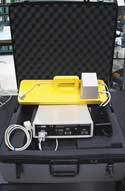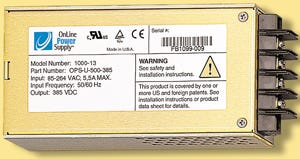Digital Panel Meter Features High-Contrast Blue LEDs
April 1, 2001
Originally Published MPMN April 2001
HOTLINE
Digital Panel Meter Features
High-Contrast Blue LEDs
Exploiting silicon carbide technology and the subsequent availability of high-contrast blue LEDs, Datel Inc. (Mansfield, MA) has launched one of the first digital panel meters with a superbright-blue LED display. The company's DMS-30-PC-BS digital voltmeter with 3 1/2-digit readout boasts large, 0.56-in.-high easily readable digits. It brings the distinctive optical and cosmetic qualities of the color blue to the instrumentation market.According to Roy Cabral, marketing manager, "Designers of medical instrumentation now have a very reliable alternative to blue vacuum fluorescent displays. Also, control-panel applications requiring a variety of display colors have the option of choosing a brilliant true blue." High-contrast blue LEDs can be used as an alternative to blue vacuum fluorescent displays.
High-contrast blue LEDs can be used as an alternative to blue vacuum fluorescent displays.
The meter uses two tight-tolerance band-gap voltage references and multiple metal-film precision resistors to achieve high accuracy and stability at all input levels. An auto-zeroing circuit ensures a zero-display reading with a zero-volt input. Four high-impedance differential input voltage ranges are available: ±200 mV, and ±2, ±20, and ±200 V. Factory calibration prior to encapsulation guarantees ±2 counts (0.1%) of full-scale accuracy. Temperature stability is ±0.15 counts per degree centigrade. The meter consumes 750 mW from a single 5-V supply.
A display-test function is standard on each device. Also available is a line of optional plug-on application boards that conveniently convert the meter into an application-specific instrument.
Karim Marouf
Environmental Analyzer Optimizes Tracker Performance
Designed for use with dc magnetic trackers, an analyzer scans the tracking environment for metallic interference and electronic noise. Offered by Ascension Technology Corp. (Burlington, VT), the analyzer helps identify unseen metals and provides cues for moving the tracker to the best location. It also tests all the electronic frequencies in the environment that might create interference in the tracker's measurements. Once it discovers such frequencies, the analyzer offers a choice of tracker measurement rates least affected by the noise source. An environmental analyzer improves tracker performance by finding hidden metallic or electronic interference.
An environmental analyzer improves tracker performance by finding hidden metallic or electronic interference.
"Our new analyzer greatly improves the quality of data collected by trackers," says technical sales account manager Greg Erdman. "It also makes many seemingly unsuitable environments surprisingly suitable, giving greater flexibility in where trackers can be used." To test the environment, users plug the analyzer into their host computer and begin scanning for invisible metal and noise. The device can be moved about a room to test floors, walls, and ceilings. A high amount of distortion in a given area will be seen as a visible color-coded patch on the computer screen. With the distortion source identified, users immediately have the ability to change the tracker's location or to move the distorting metal. Applications for the analyzer include 3-D ultrasound and medical training simulators.
Katherine Sweeny
Power Supply Modules Feature Small Footprint, Low Weight
Design engineers have long struggled with having to incorporate big, heavy power supplies into their equipment. A solution may be available at last. OnLine Power Supply Inc. (Englewood, CO) has produced power factor–corrected front-end modules that are small, light, reliable, and efficient. Furthermore, the power supplies are not affected by thermal deration.According to Kris Budinger, president and CEO, "The units are more than 97% efficient. They feature internal EMI filters and hold-up capacitors. Providing more power with less size will allow medical device engineers greater freedom in their designs." Budinger spoke to MPMN editors at a press conference introducing the power supplies. This power supply measures 2.9 x 1.6 x 5.7 in. and weighs less than 2 lb.
This power supply measures 2.9 x 1.6 x 5.7 in. and weighs less than 2 lb.
The units measure 2.9 x 1.6 x 5.7 in. and weigh less than 2 lb. Because they generate a low level of heat, bulky cooling fans can be eliminated. The supplies can function at full power in temperatures ranging from –40° to 85°C. Universal input allows worldwide use.
Budinger was hesitant in revealing to the MPMN editors what new technology these power supplies use to achieve their dramatic results. "We have a lot of patents pending," he said. "In the future we can be more open in talking about the technologies involved."
Karim Marouf
Medical Product Manufacturing News is always on the lookout for innovative products and services. If you are aware of any that have recently been or are about to be introduced, please call the Hotline editor, Karim Marouf, at 310/445-4267.
You May Also Like


